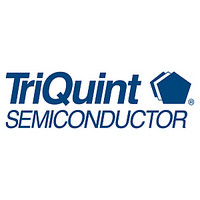AP501-PCB TriQuint, AP501-PCB Datasheet - Page 2

AP501-PCB
Manufacturer Part Number
AP501-PCB
Description
RF Modules & Development Tools 1.93-1.99GHz Brd 12V 4W 3-stage
Manufacturer
TriQuint
Datasheet
1.AP501-PCB.pdf
(5 pages)
Specifications of AP501-PCB
Minimum Frequency
1.93 GHz
Minimum Operating Temperature
- 40 C
Supply Voltage (min)
5 V
Product
RF Development Tools
Maximum Frequency
1.99 GHz
Supply Voltage (max)
12 V
Supply Current
840 mA
Maximum Operating Temperature
+ 85 C
Lead Free Status / RoHS Status
Lead free / RoHS Compliant
WJ Communications, Inc • Phone 1-800-WJ1-4401 • FAX: 408-577-6621 • e-mail: sales@wj.com • Web site: www.wj.com, www.TriQuint.com
The AP501-PCB and AP501 module is configured for Class AB by default. The resistor – R7 – which sets the current draw for
the amplifier is set at 0 Ω in this configuration. Increasing that value will decrease the quiescent and operating current of the
amplifier module, as described on the next page.
RF IN
33
32
31
30
29
28
27
-20
-40
40
20
1930
0
0
AP501
PCS-band 4W HBT Amplifier Module
S21
S11
S22
DNP
Narrowband S-Parameters
500
Performance Graphs – Class AB Configuration (AP501-PCB)
1950
Frequency (MHz)
Wideband S-Parameters
0Ω
+25 °C, Icq=850mA
1000
Frequency (MHz)
DNP
DNP
+25 °C, Icq=850mA
1500
DNP
1970
0Ω
2000
S21
S11
S22
2500
DNP
1990
6
100pF
.01μF
0
-5
-10
-15
-20
-25
-30
5
3000
4
3
1000
0Ω
-50
-60
-70
-80
-90
2
950
900
850
800
750
22
24
DNP
DNP
1
IS-95A, 9 Channels forward, 1FA, 1960 MHz, Icq=850mA
±885 kHz
±1.25 MHz
Icc
23
PAE / Icc vs. Output Power
26
Output Channel Power (dBm)
1960 MHz, +25 °C, Icq=850mA
10μF
Output Power (dBm)
ACPR vs. Channel Power
24
28
PAE
DNP
100pF
.01μF
0Ω
25
30
26
32
DNP
RF OUT
27
34
25
20
15
10
5
0
Notes:
1. Please note that for reliable operation, the evaluation board will have to
2. The area around the module underneath the PCB should not contain any
3. For proper and safe operation in the laboratory, the power-on sequencing
28
Specifications and information are subject to change without notice
be mounted to a much larger heat sink during operation and in laboratory
environments to dissipate the power consumed by the device. The use of
a convection fan is also recommended in laboratory environments.
Details of the mounting holes used in the WJ heatsink are given on the
last page of this datasheet.
soldermask in order to maintain good RF grounding.
should be followed:
a. Connect RF In and Out
b. Connect the voltages and ground pins as shown in the circuit.
c. Apply the RF signal
d. Power down with the reverse sequence
-40
-50
-60
-70
36
34
32
30
28
26
18
-6
+25°C, 3GPP wCDMA, 1FA, 1+32 DPCH, ±5 MHz offset, 1960 MHz, Icq=850mA
Gain / Output Power vs. Input Power
-40 C
+25 C
+85 C
-4
20
Output Channel Power (dBm)
1960 MHz, +25 °C, Icq=850mA
Input Power (dBm)
ACLR vs. Channel Power
Product Information
-2
22
0
2
24
Page 2 of 5 July 2008
4
Pout
Gain
26
6
32.5
32
31.5
31
30.5
30
28






